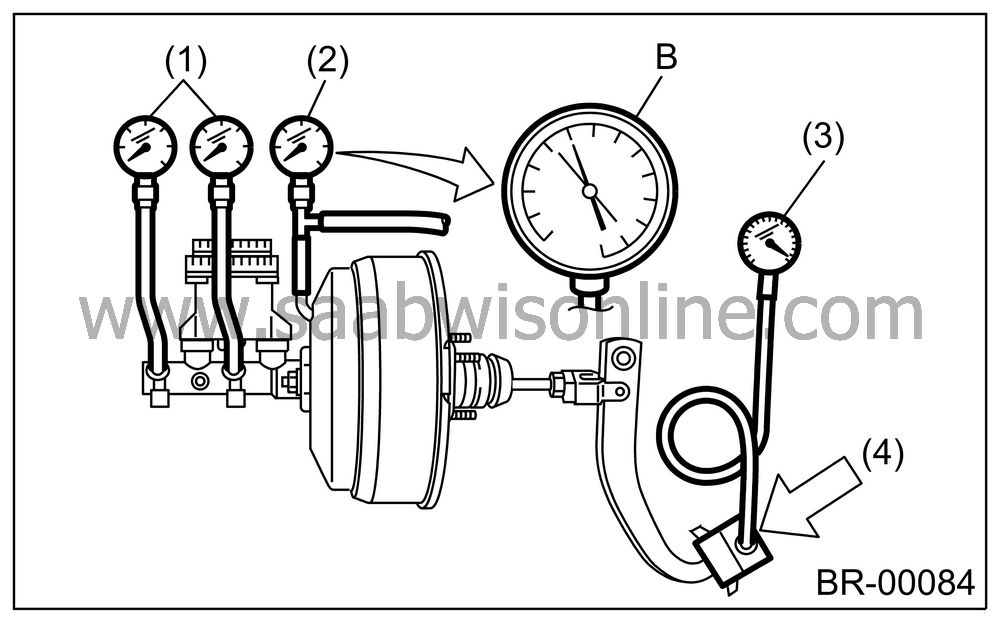INSPECTION
| INSPECTION |
| OPERATION CHECK (WITHOUT GAUGES) |
| Important | ||
|
When checking operation, be sure to securely apply the parking brake. |
||
Checking without gauges
This method cannot determine the exact portion which has failed, but it can provide a rough understanding of the nature of failure if checking is conducted in accordance with the following procedures.Air tightness check
Start the engine, and run it for 1 to 2 minutes, then turn it off. Depress the brake pedal several times applying same pedal force as that used in ordinary braking operations. The pedal stroke should be greatest on 1st depression, and it should become smaller with each successive depression. If no change occurs in the pedal height while in a depressed state, the brake booster is faulty.
|
(1)
|
OK
|
|
(2)
|
NOT OK
|
|
(3)
|
1st
|
|
(4)
|
2nd
|
|
(5)
|
3rd
|
| Note | ||
| • |
In the event of defective operation, inspect the condition
of check valve and vacuum hose.
|
|
| • |
Replace them if faulty and conduct the test again.
|
|
| • |
If no improvement is observed, check precisely with
gauges.
|
|
Operation check
With the engine off, depress the brake pedal several times applying same pedal force and make sure that pedal height does not vary with each depression of pedal.
|
(1)
|
When engine
is stopped
|
|
(2)
|
When engine
is started
|
With the brake pedal depressed, start the engine.
As the engine starts, the brake pedal should move slightly toward the floor. If no change occurs in the pedal height, the brake booster is faulty.
| Note | ||
|
If faulty, check precisely with gauges. |
Loaded air tightness check
Depress the brake pedal while engine is running, and turn off the engine while pedal is still depressed. Keep the pedal depressed for 30 seconds; if no change occurs in the pedal height, the brake booster is functioning normally; if the pedal height increases, it is faulty.| Note | ||
|
If faulty, check precisely with gauges. |
| OPERATION CHECK (WITH GAUGES) |
| Important | ||
|
When checking operation, be sure to securely apply the parking brake. |
||
Checking with gauges
Connect gauges as shown in the figure. After bleeding air from pressure gauges, proceed to each check.
|
(1)
|
Pressure
gauge
|
|
(2)
|
Vacuum
gauge
|
|
(3)
|
Adapter
hose
|
|
(4)
|
Vacuum
hose
|
|
(5)
|
Pedal force
gauge
|
Air tightness check
Start the engine and keep it running until a vacuum of 66.7 kPa (500 mmHg, 19.69 inHg) = point A is indicated on vacuum gauge. Do not depress the brake pedal.
|
(1)
|
Pressure
gauge
|
|
(2)
|
Vacuum
gauge
|
Stop the engine and watch the gauge. If the vacuum drop range is less than 3.3 kPa (25 mmHg, 0.98 inHg) within 15 seconds after stopping engine, the brake booster is functioning properly.
If defective, the cause may be one of those listed below.
| • |
Check
valve malfunction
|
|
| • |
Leak from vacuum hose
|
|
| • |
Leak from the shell jointed portion or stud bolt welded
portion
|
|
| • |
Damaged diaphragm
|
|
| • |
Leak from valve body seal and bearing portion
|
|
| • |
Leak from plate and seal assembly portion
|
|
| • |
Leak from poppet valve assembly portion
|
|
Loaded air tightness check
Start the engine and depress brake pedal with pedal force of 196 N (20 kgf, 44 lb). Keep the engine running until a vacuum of 66.7 kPa (500 mmHg, 19.69 inHg) = point B is indicated on vacuum gauge while the pedal is still depressed.
|
(1)
|
Pressure
gauge
|
|
(2)
|
Vacuum
gauge
|
|
(3)
|
Pedal force
gauge
|
|
(4)
|
Depress
|
Stop the engine and watch vacuum gauge.
If the vacuum drop range is less than 3.3 kPa (25 mmHg, 0.98 inHg) within 15 seconds after stopping engine, the brake booster is functioning properly.
If defective, refer to “AIR TIGHTNESS CHECK”.

If any fault is found on brake booster, replace the brake booster with a new one.
Lack of boosting action check
Turn off the engine, and set the vacuum gauge reading at “0”. Then, check the fluid pressure when brake pedal is depressed. The pressure must be greater than the standard value listed.|
Brake pedal force
|
147
N
(15 kgf, 33 lb) |
294
N
(30 kgf, 66 lb) |
|
|
Fluid pressure
|
Saab
9-2X 2.0T Aero AT
|
686
kPa
(7 kg/cm 2 , 100 psi) |
1,667
kPa
(17 kg/cm 2 , 242 psi) |
|
Saab
9-2X 2.0T Aero MT
|
588 kPa
(6 kg/cm 2 , 85 psi) |
1,471 kPa
(15 kg/cm 2 , 213 psi) |
|
|
Saab
9-2X 2.5i Linear
|
|||
Boosting action check
Set the vacuum gauge reading at 66.7 kPa (500 mmHg, 19.69 inHg) by running engine. Then, check the fluid pressure when brake pedal is depressed. The pressure must be greater than the standard value listed.|
Brake pedal force
|
147
N
(15 kgf, 33 lb) |
294
N
(30 kgf, 66 lb) |
|
|
Fluid pressure
|
Saab
9-2X 2.0T Aero AT
|
6,374
kPa
(65 kg/cm 2 , 925 psi) |
10,000
kPa
(102 kg/cm 2 , 1,450 psi) |
|
Saab
9-2X 2.0T Aero MT
|
5,688
kPa
(58 kg/cm 2 , 825 psi) |
9,120 kPa
(93 kg/cm 2 , 1,323 psi) |
|
|
Saab
9-2X 2.5i Linear
|
5,296
kPa
(54 kg/cm 2 , 768 psi) |
||


